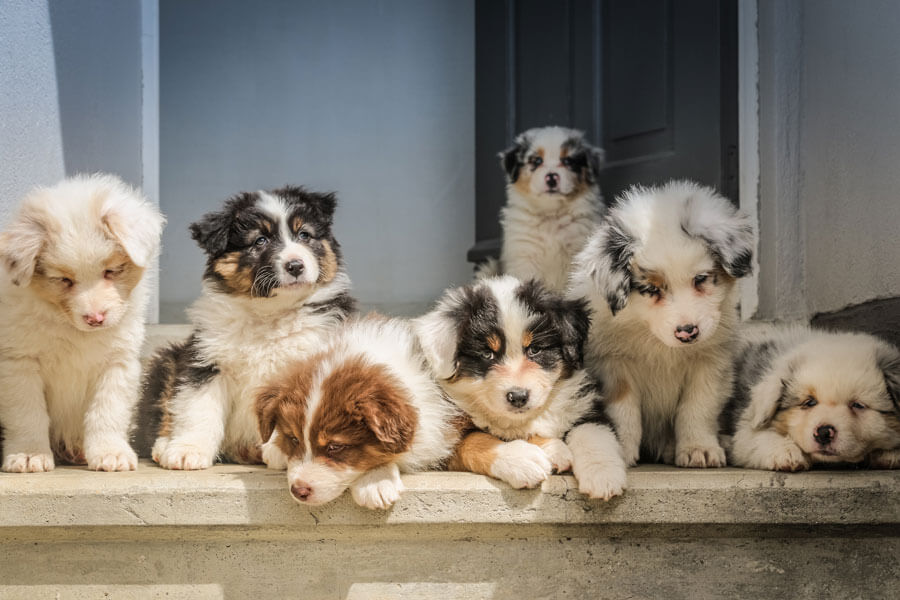Last Updated on July 9, 2021 by Fumipets
Generally, only large-scale and professional dog breeders are required to get a kennel licence to continue operating their kennel. However, depending on whatever state you live in, the definition of a professional dog breeder varies.
If you breed more than two litters each year, certain states require you to acquire a dog breeding licence. Other dog breeder permits, on the other hand, are mainly dependent on income earned. Licensing, like taxes, is a complex subject, but you must follow your state’s laws and any other regulations in place. Some breeders wish to be licenced in order to demonstrate their professionalism – but this may also be deceptive!

Who Issues Dog Breeding Licenses?
Commercial dog breeding permits and kennel inspections are handled by individual states as well as federal agencies (such as the USDA). Because it is dependent on the state in which you reside, this is a more difficult question to answer directly. Some states make it simpler by requiring just one authority to grant the licence. Other states, on the other hand, need all authorities to sign off on a licence.
Breeders and bigger kennel owners are subject to specific standards of care in at least 19 states (e.g. Connecticut). State authorities establish administrative rules, and failure to follow them may result in the cancellation of a breeder’s licence, civil fines, or criminal penalties.
In general, when a person engages in a large-scale breeding activity for the sole purpose of profit, a breeding licence is needed. In certain places, like Florida, you may be required to obey municipal regulations; nevertheless, breeders should always respect federal and state laws. The kind of licence granted is determined by the number of dogs bred and the amount of profit made.
Keep in mind that the AKC does not issue any breeder’s licences. They are just a dog registry. Even if they have their own optional accreditations, as many kennel organisations have, it isn’t considered a licence. These accreditations do not serve the same function as a state licence, which may be required in certain cases.

Animal Welfare Act
AWA (Animal Welfare Act) is the federal legislation that regulates pet breeders. This law protects and controls the living circumstances of both dogs and cats.
Breeders that make $500 or more in profit each year are subject to these regulations, while retail breeders are exempt. The AWA necessitates obtaining a licence from the US Department of Agriculture. On the other hand, regulations are in place at the state level for both retail and wholesale pet dealers that sell more than two litters each year.
Local Laws
On a municipal level, commercial breeding regulations issue two kinds of permits. Commercial licences are given to individuals who earn more than 25% of their income from a business, and some municipal regulations impose fees based on yearly sales. Hobby breeder licence holders who breed dogs and cats on their own property are restricted to just two litters each year in certain areas.
Do I Need a License to Breed my Dogs?
It is generally not necessary to get a formal licence in order to breed your dogs. However, it is very much dependent on the state in which you are presently breeding. As earlier said, each state has its own set of rules that local breeders must adhere to. Breeders must consider the fact that the quantity of dogs bred makes a significant impact. This number typically indicates whether a mandatory licence may be needed in the future.
In general, if you plan on breeding a significant number of dogs in a short period of time, such as a year, you may be required to acquire a commercial breeder licence. Many jurisdictions will also consider the total number of dogs or animals that a prospective breeder is currently breeding. These limits may differ from one state to the next.
This does not apply to “hobby breeders” who only have one or two litters every several years. Most dog owners who do not spay or neuter their pets will eventually find themselves in a position where one of their dogs starts to reproduce. Puppies are usually given away or reared at home under these normal procedures, rather than being sold and utilised for profit.
When a breeder produces a significant number of litters, however, they risk being examined and audited. If you run a large company, you will almost certainly be required to get a licence. Additionally, the IRS may be interested in your dog breeding earnings and if you have been appropriately taxed on them.

Application For Commercial Dog Breeding License
To become a certified commercial dog breeder, one needs to go through the procedure of obtaining a licence.
Specific procedures must be completed, and different criteria must be considered, from filling out certain paperwork to getting confirmation (or rejection). To acquire an official dog breeding licence, a number of requirements must be met.
The breeder will need a lot of time and patience to finish this procedure, which may take many months. As a result, a breeder must be aware of the long timeframe at all times and prepare appropriately. Breeders should be allowed to continue their regulated operations while applying for a licence and waiting for it.
Necessary Forms & Materials
Requesting licencing paperwork from your state’s Animal Care Office is the first step in getting a commercial dog breeding licence. Also, you may request or download a pre-license information package to assist you with the paperwork. This package will provide you with all the information you need to get started, including necessary papers, fees, and basic information that all breeders should know. It may be a good idea to assess your facility now to ensure that it does not violate any AWA requirements and to work on fixing any mistakes.

Application
After that, you’ll need to submit an application for a dog breeding licence. Complete the necessary application and submit it to the Animal Care Office responsible for your state in your local region. The following items are included in a full licencing application:
an APHIS Form 7003-A,
an application fee of about $10, and
a Taxpayer Identification Number (TIN).
This is all of the information that will be required in order to apply. Before being delivered to an inspector, these items will be evaluated by your state’s Animal Care Office. These forms are needed and may be obtained here.
Pre-License Inspection
All of the papers will be reviewed by the inspector assigned to your application. Within 10 days after receiving the application from the Animal Care Office in your region, he will contact you. Only then will the pre-license inspection be scheduled by the office. If you have any queries, you may call the inspector at any time throughout the waiting period. These are the only pre-license inspections that will be arranged with an inspector.
All further inspections will be unannounced after you have been licenced. As a result, it’s essential that you properly prepare all of your documents, as well as your facility, in accordance with the Animal Welfare Act, in order to pass the first inspection.
Time Limit
The Animal Welfare Acts Rules provide that a breeder may have three inspections in a 90-day period to show compliance with the act and regulations, starting from the date of the first inspection.
To show compliance with the conditions, you have 90 days from the inspector’s first inspection OR three inspections after the inspector has visited your facility for the first pre-license inspection, whichever comes first.
If you have any questions about when you may begin performing regulated activities, contact your local Animal Care Office.
Getting Ready for the Inspection
Knowing and comprehending the regulatory criteria, as well as verifying your facility conforms with official AWA requirements, is the best approach to properly prepare for the inspection. The inspector will examine the facility to see whether it complies with the AWA standards.
The Animal Welfare Act rules are included in the USDA APHIS Animal Care pre-licensing information package. You may find the minimal standards for animal care, housing, and general welfare at your facility there.
Records
For the inspector’s evaluation, applicants must submit paperwork and records. A Program of Veterinary Care (APHIS Form 7002), which is a written plan approved by your Attending Veterinary, is included in these documents. In order to show health and physical activity plans and statuses, you will need an exercise plan from your veterinarian as well as health documents.
You must also submit an Acquisition of Dogs and Cats on Hand (APHIS Form 7005) as proof of how the animals on the property were obtained. Finally, there’s a document called Disposition of Dogs and Cats on Hand (APHIS Form 7006) that you may fill out to keep track of when animals depart the facility.
Identification
Regulations demand that the animals used for breeding be identified, and this must be done on APHIS Forms 7005 and 7006. Collars and tags with the USDA number, a microchip, or a tattoo must be worn by the dogs. Once the breeder has been licenced, the official licence number will be given, so identify as completely as possible for the pre-licensing inspection and complete once the licence has been obtained.

Facilities
Housing details, sanitary procedures, and appropriate husbandry techniques are all important criteria for candidates. Before any licence may be approved, applicants must demonstrate that they conform to the rules in respect to these criteria.
Inspection
The inspector will want to be shown through the whole kennel on the day of the inspection. Inspectors may look at the animals and their surroundings as closely as they choose. Before going on, they go through the information and records on the application. Inspections are routinely photographed and videotaped.
Your inspector will next provide an informative presentation, review the animals’ vet, husbandry, and exercise programmes, and answer any questions the breeder may have. An inspection’s duration is determined by the size and kind of facility, the number of animals, and a range of other variables like the number of records.
The breeder will be refused a licence if the inspection results in non-compliant goods being presented to the inspector, which is usually due to:
failing to comply with a federal statute or rule, being found in violation of state law, having a prior licence revoked or suspended, or failing to submit a complete application
If there are no non-compliant items during the inspection after the departure briefing, you will be qualified for the licence.

How to Renew a Commercial Breeding License?
From the date of issuance, the USDA licence will be valid for one year. The license’s expiry date may be seen on the certificate. For an applicant to be in good standing, the renewal payments and application must be submitted before or on the day the licence expires.
If the licence is cancelled owing to a failure to renew it properly, the licensee must reapply for a completely new licence. This entails filing a pre-license application once again. You’ll have to repeat the whole pre-license inspection procedure.
It is your duty to ensure that all renewal documents, such as the following, reach the Animal Care Office.
A completed APHIS Form 7003, a signed item 12 recognising the rules, a $10 application fee, a licencing fee calculated by a fee computation contained in the licence renewal package, and a Taxpayer Identification form are all required.
After you’ve completed your application, the commercial breeding licence renewal procedure will begin, and you’ll get written confirmation within a few weeks. If you haven’t heard anything after two to four weeks, contact your licencing office.


















